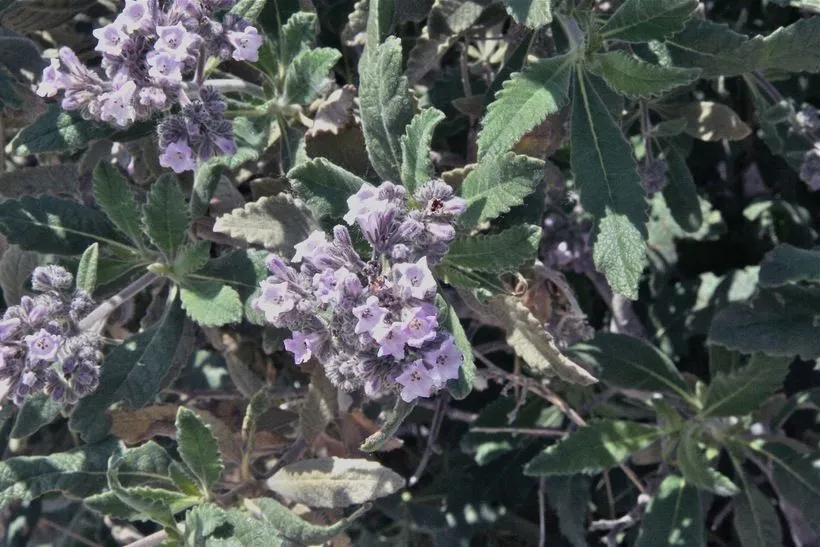
Author: Benth.
Bibliography: Bot. Voy. Sulphur: 35 (1844)
Year: 1844
Status: accepted
Rank: species
Genus: Eriodictyon
Vegetable: False
Observations: California
Thick-leaf yerba-santa, known scientifically as Eriodictyon crassifolium, is an intriguing plant species recognized for its medicinal and ecological significance. This species was first described in the 1844 publication “Botanical Voyage of the Sulphur,” authored by the renowned botanist George Bentham.
Native to California, the thick-leaf yerba-santa belongs to the Boraginaceae family. The common name “yerba-santa” translates to “holy herb” in Spanish, reflecting its traditional usage by indigenous peoples and early settlers for various medicinal purposes, including treatments for respiratory ailments, wounds, and fever.
The plant is characterized by its robust, evergreen leaves, which are distinctly thick and sticky to the touch, a notable adaptation that helps it survive in arid conditions. These leaves emit a resinous aroma when crushed, indicative of the natural compounds they contain, which have been utilized in herbal medicine.
Typically found in chaparral and coastal scrub habitats, thick-leaf yerba-santa thrives in the warm, Mediterranean climate of California. It plays a vital role in the local ecosystem, providing food and shelter for various insects and wildlife. The plant also demonstrates impressive adaptability to fire-prone environments, often resprouting vigorously after wildfires.
In addition to its ecological niche, Eriodictyon crassifolium garners interest for its potential in modern medicine, as ongoing research explores its various bioactive compounds. This exploration aims to validate and expand upon the traditional knowledge of its medicinal properties.
Overall, thick-leaf yerba-santa is a remarkable plant not only for its historical and cultural significance but also for its potential contributions to modern science and its resilience in the face of environmental challenges.
Eng: thick-leaf yerba-santa, thickleaf yerba santa
Swe: tjockbladig balsambuske
En: Thick-leaf yerba-santa, Thickleaf yerba santa
Fi: Nukkaintiaanipalsami
Sv: Tjockbladig balsambuske
Taken Aug 14, 2014 by EOL − Zoya Akulova (cc-by-nc)
Taken Aug 14, 2014 by EOL − Zoya Akulova (cc-by-nc)
Taken Jan 24, 2015 by EOL − Keir Morse (cc-by-nc-sa)
Taken Apr 11, 2021 by Bigfoot (cc-by-sa)
Taken Apr 11, 2021 by Bigfoot (cc-by-sa)
Taken Mar 29, 2019 by Rissa Rissa (cc-by-sa)
Taken Apr 2, 2016 by EOL − Dale Hameister (cc-by-nc)
Taken Apr 11, 2021 by Bigfoot (cc-by-sa)
Taken Jan 24, 2015 by EOL − Keir Morse (cc-by-nc-sa)
Taken Jan 24, 2015 by EOL − Keir Morse (cc-by-nc-sa)
Taken Mar 8, 2016 by EOL − Steven Thorsted (cc-by-nc)
Taken Dec 2, 1998 by EOL − Charles Webber (cc-by-nc-sa)
Taken Jan 28, 2013 by EOL − Keir Morse (cc-by-nc-sa)
Taken Jan 28, 2013 by EOL − Keir Morse (cc-by-nc-sa)
Taken Jan 28, 2013 by EOL − Keir Morse (cc-by-nc-sa)
Taken Feb 21, 2022 by Johnny Poppyseed (cc-by-sa)
Taken Jan 28, 2013 by EOL − Keir Morse (cc-by-nc-sa)
© copyright of the Board of Trustees of the Royal Botanic Gardens, Kew.
© copyright of the Board of Trustees of the Royal Botanic Gardens, Kew.
© copyright of the Board of Trustees of the Royal Botanic Gardens, Kew.
Growth habit>: Shrub
Family: Myrtaceae Author: (F.Muell.) K.D.Hill & L.A.S.Johnson Bibliography: Telopea 6: 402 (1995) Year: 1995 Status:…
Family: Rubiaceae Author: Pierre ex A.Froehner Bibliography: Notizbl. Bot. Gart. Berlin-Dahlem 1: 237 (1897) Year:…
Family: Sapindaceae Author: Koidz. Bibliography: J. Coll. Sci. Imp. Univ. Tokyo 32(1): 38 (1911) Year:…
Family: Asteraceae Author: A.Gray Bibliography: Pacif. Railr. Rep.: 107 (1857) Year: 1857 Status: accepted Rank:…
Family: Fabaceae Author: Medik. Bibliography: Vorles. Churpfälz. Phys.-Ökon. Ges. 2: 398 (1787) Year: 1787 Status:…
Family: Aspleniaceae Author: (Cav.) Alston Bibliography: Bull. Misc. Inform. Kew 1932: 309 (1932) Year: 1932…